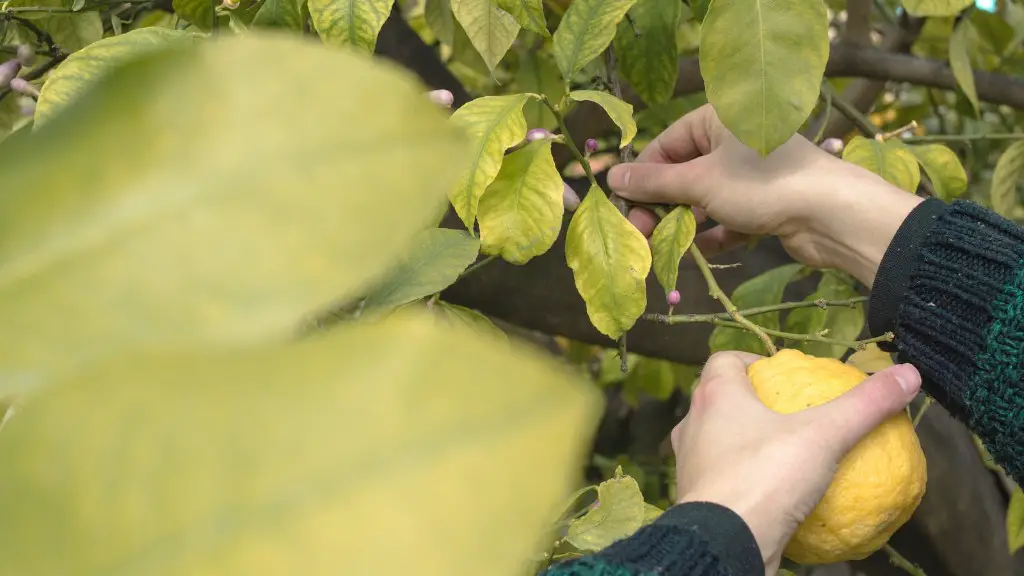When it comes to caring for a lemon tree, knowing when to cut it is an important task. Pruning lemon trees is often necessary to ensure the tree produces healthy fruit and remains strong. Depending on how the tree is shaped and how much of a pruning budget is available, trimming can be done in two different ways: lightly pruning or removing large branches or even the entire tree.
When deciding to trim a lemon tree, the size and age of the tree should be taken into account. If the tree is still young and not growing well, less invasive measures can be taken such as cutting off any dead or damaged branches, or pruning back any unruly branches. The same approach can be taken if the tree is mature and healthy and just needs some light tidying.
If the tree is not growing properly and needs more than light trimming, removing some large branches may be necessary. These cuts can be made using a pair of secateurs or pruning saw and should be made just above the point where the branch meets with the tree trunk. It is important to avoid cutting close to the trunk as this can create an open wound, inviting disease and insects.
In some cases, when the tree is old or diseased, it is best to remove the entire tree. This can be done by cutting the trunk close to the base and then grinding the remaining stump. This requires the use of a specialised tree-cutting tool, such as a chainsaw, and should only be undertaken by experienced professionals.
When pruning a lemon tree, it is important to remember that large cuts can cause the tree to become unbalanced, reducing its potential for growth and fruit production. Therefore, care should be taken when deciding which branches to cut, as only those that are clearly dead, damaged, or overcrowded should be pruned.
Fertilizing Lemon Trees
Fertilizing lemon trees is an important step to promote healthy growth and extend its rate of production. Lemon trees should be fertilized twice a year, in the spring and mid-summer, with an appropriate fertilizer for citrus plants.
When selecting a fertilizer, ensure that it is specifically designed for citrus trees, and for best results, apply it when the tree is in a new growth cycle. Fertilizing the lemon tree should also include a regular application of compost or mulch to provide additional nutrients to the tree.
Foliar fertilizers can also be used to give the tree a boost of nutrients and should be applied to the leaves in the spring and summer months. Foliar fertilizers are applied using a practical spray bottle and must be applied with caution to avoid any damage to the leaves.
It is also important to note that fertilizing lemon trees should not be done too frequently, as this can lead to excess nutrient build-up in the soil and detriment the plant growth. For this reason, it is important to follow the manufacturer’s instructions when it comes to fertilizing the tree.
Watering Lemon Trees
Regular and sufficient watering is an important factor in ensuring the health of a lemon tree. Depending on the climate and amount of rainfall, lemon trees should be watered about once a week. If the tree is kept in a pot, it will require more frequent watering as the soil tends to dry out faster.
When it comes to watering the tree, a slow trickle of water should be applied at least 15 centimetres away from the trunk and over the entire tree in a circular motion. To ensure that the tree is getting the correct amount of water, it is important to deep water it – an example of this is flooding the soil and letting it soak in before repeating the process.
It is also important to note that an over-abundance of water can be damaging to a lemon tree. To avoid over-watering, it is best to check the soil before each watering to assess its state. If the soil feels dry, then the tree should be watered, but if it is damp, then it should be left until the soil dries slightly.
In addition to watering the tree, mulching the soil around the tree can help to retain the moisture in the soil and deter weed growth. This can be done by layering a few inches of compost, straw, or leaves around the base of the tree.
Pest and Disease Prevention
When caring for a lemon tree, it is important to be aware of potential diseases and pests that can affect the tree and its fruit. To this end, there are a few steps that can be taken to protect the tree from pests and diseases.
The first step is to keep the tree free from weeds by regularly removing any weeds or debris growing near the trunk. This is not only beneficial as it prevents weeds from crowding the tree, but it also discourages pests from taking over the tree. Furthermore, it is important to avoid over-watering the tree as this can cause root rot, a common issue among citrus trees in wetter climates.
Regularly checking the tree leaves and branches for pests is also another important preventive measure. Common pests include the citrus leafminer, which feeds on the leaves of the tree, and citrus gall wasp, which can infest the fruit. If any pests are found on the tree, it is recommended that they be removed manually or with the use of specialised pest control solutions.
Finally, it is also important to use beneficial insects for pest control. Beneficial insects are natural predators of pest insects and can help reduce the amount of pests on the lemon tree. A popular example of a beneficial insect is the ladybug, which is effective at preying on aphids, a common citrus pest.
Training Lemon Trees
An essential part of caring for a lemon tree is pruning and training it correctly. Pruning a lemon tree should be done with the purpose of improving air circulation, promoting healthy growth, and creating a shape suitable for good fruit production.
When training a lemon tree, it is important to bear in mind that the desired shape will depend on the space available. In general, a lemon tree should have a central leader and open limbs that do not cross each other. It is also important to prune back any weak or unruly branches and maintain the desired shape.
A more intensive pruning approach can also be taken if desired, such as pruning out inward-growing branches or those that cross one another. This is an excellent way to create an open canopy that allows light and air to penetrate the tree and promote its health. In contrast to this, a light pruning technique is recommended for young or small trees.
The timing of pruning is also important when it comes to a lemon tree. It is recommended to prune established lemon trees in late winter just before the start of the new growing season. Pruning can also be done during the summer months to reduce the height of the tree and tame wayward branches.
Harvesting Lemon Trees
Once a lemon tree has reached maturity, it is time to start harvesting its fruits. The harvesting time of a lemon tree will depend on the type of lemon tree and the climate in which it is growing. In general, most lemon trees will be ready to harvest from mid-summer to late autumn.
To determine if a lemon is ready to harvest, the best indicator is to assess its colour. Depending on the variety, the lemon fruit should be bright yellow if it is ready to pick. If the lemons are still green, then it is better to leave them to ripen on the tree.
When harvesting the lemons, it is important to remove any unwanted fruits first or those with visible damage. This helps to reduce the risk of infection and promote healthier fruit production down the line. In addition to this, it is best to use a pair of secateurs to make a clean cut, otherwise the branches can be damaged and result in weak growth.
Finally, it is important to note that harvesting lemon trees should be done with caution, as too much fruit can be devastating to the tree’s health, reducing its future production. Therefore, it is recommended to only harvest the tree when it is deemed necessary and when the right amount of fruit is available.
Pest Control and Disease Prevention
Pest control and disease prevention is an important factor in caring for a lemon tree and maintaining its health. To ensure that the tree does not get infested with pests and diseases, there are a few preventative measures that can be taken.
The most effective method of pest control is to keep the tree free from weeds, as these are often a source of pests. To this end, weeds should be removed from around the base of the tree and from underneath any surrounding plants. This helps to discourage pests from taking up residence in the tree and encourages beneficial insect presence.
In addition to this, it is also important to inspect the tree leaves and branches for pests regularly. If pests are found, they should be removed immediately, either manually or with the use of specialised pest control solutions.
The tree can also be sprayed with beneficial insecticides, such as ladybugs, which are natural predators of pests. This helps to reduce the amount of pests on the tree and promote its natural health.
Finally, disease prevention can be achieved by using a fertilizer specifically formulated for citrus trees and avoiding over-watering the tree. Over-watering can lead to root rot, which is a common issue among citrus trees in wetter climates. To ensure that the tree is getting enough water, the soil should be checked before each watering.
Fruit Care and Harvesting
When the lemon tree has reached maturity and the fruit is ready to pick, it is important to ensure that the fruit is kept in the best possible condition to maintain its quality. To this end, it is important to be aware of the harvesting process and how to store fruits correctly.
When harvesting the lemons, it is important to use a pair of secateurs to make a clean cut and remove any unwanted fruit first or those that are visibly damaged. This helps to avoid the risk of infection and promote healthier production in the future.
When it comes to storing the fruit, it is best to keep the lemons in an area that is cool, dark and dry in order to preserve their quality. For this reason, it is not recommended to leave lemons on the tree for longer than is necessary, as this can lead to the fruits becoming over-ripe.
In addition to this, it is important to check the lemons regularly for signs of decay or mould. If found, the affected fruits should be removed straight away to prevent them from infecting the other fruits.
Finally, the lemons should be stored in boxes or baskets and packed away from each other to avoid bruising or damaging of the skin. This helps to maintain the quality of the fruit and ensure it stays safe and healthy until it is ready to be consumed.


